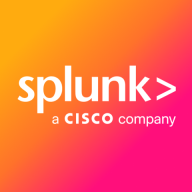

Securonix Next-Gen SIEM and Splunk Enterprise Security are key contenders in the security software sector, each offering robust solutions for distinct user needs. Securonix tends to have an advantage in cloud-native environments with its sophisticated threat detection and user behavior analytics, which work well for organizations prioritizing these features. Splunk shines with its capacities in data aggregation and customization, making it highly scalable and integrable.
Features: Securonix offers behavior analytics, threat chaining, and flexible cloud integration, employing machine learning to reduce false positives and provide insights in cloud-first setups. Splunk provides comprehensive real-time security intelligence, customizable dashboards, and robust data correlation abilities, ideal for large-scale deployments with its specialized search language, despite higher costs associated with advanced operational intelligence tools.
Room for Improvement: Securonix users desire improved service integration, enhanced automation, more intuitive customization, and faster support, as well as better reporting features. For Splunk, users voice concerns over high licensing costs and a steep learning curve, citing the need for flexible pricing models, enhanced AI features, and stronger deployment support to improve overall user experience and efficiency.
Ease of Deployment and Customer Service: Securonix supports smooth cloud-based deployments, generally backed by proactive customer service, though there are occasional delays handling complex issues. Splunk features a challenging deployment process requiring significant resources and expertise due to extensive capabilities, and while customer service is responsive, there’s a call for more transparent communication, particularly for on-premises setups.
Pricing and ROI: Securonix offers a predictable user-based pricing model, assisting with budget forecasting and delivering quick ROI, seen as cost-effective post-deployment due to significant savings. Although Splunk's data-based pricing challenges budget-conscious organizations, its extensive analytics and comprehensive insights often justify the investment for larger enterprises needing detailed data exploration and insights.
The solution is time-saving, particularly in the long run after it is deployed, enabling us to get value promptly.
The documentation for Splunk Enterprise Security is outstanding. It is well-organized and easy to access.
We couldn't calculate what would have been the cost if they had actually gotten compromised; however, they were in the process, so every investment was returned immediately.
On average, my SecOps team takes probably at least a quarter of the time, if not more, to remediate security incidents with Splunk Enterprise Security compared to our previous solution.
There is no UK-based support, which leads to delays in waiting for US support.
If I raise a ticket, it initially goes to the L1 team, but the next level of escalation is really effective.
They excel in response times and quick reactions when there's an actual threat.
We have paid for Splunk support, and we’re not on the free tier hoping for assistance; we are a significant customer and invest a lot in this service.
I have had nothing but good experiences with Splunk support, receiving timely and helpful replies.
We've had great customer success managers who have helped us navigate scaling from 600 gigs to 30 terabytes.
I can rate it around eight to nine, and it is very scalable and capable of handling tasks, especially for the on-premises product.
We have not had any customers come back to say they cannot scale at the speed of their business growth.
The solution is scalable as it is cloud-based and cloud-native.
We currently rely on disaster recovery and backup recovery, which takes time to recover, during which you're basically blind, so I'm pushing my leadership team to switch over to a clustering environment for constant availability.
They struggle a bit with pure virtual environments, but in terms of how much they can handle, it is pretty good.
It is easy to scale.
The stability of Securonix Next-Gen SIEM is based on the events we are processing.
They test it very thoroughly before release, and our customers have Splunk running for months without issues.
Splunk has been very reliable and very consistent.
It provides a stable environment but needs to integrate with ITSM platforms to achieve better visibility.
At the admin level, we have many challenges where log parsing is causing issues and compatibility is not present.
The passing and setup are quite complex at the beginning, making onboarding not smooth.
SIEM could have better integration with other technologies.
Improving the infrastructure behind Splunk Enterprise Security is vital—enhanced cores, CPUs, and memory should be prioritized to support better processing power.
Splunk Enterprise Security is not something that automatically picks things; you have to set up use cases, update data models, and link the right use cases to the right data models for those detections to happen.
For any future enhancements or features, such as MLTK and SOAR platform integration, we need more visibility, training, and certification for the skilled professionals who are working.
Licensing is based on events per second (EPS), costing between $50 to $60 per EPS.
The solution is definitely not expensive.
The pricing has similar ingestion charges compared to other solutions, such as Splunk.
I saw clients spend two million dollars a year just feeding data into the Splunk solution.
The platform requires significant financial investment and resources, making it expensive despite its comprehensive features.
I find it to be affordable, which is why every industry uses it.
The software includes user behavior interactions, dashboards, and training capabilities.
Now, the process is automatic, reducing our workload.
The other SIEM solutions lack an option for big data analysis, whereas in the Securonix Next-Gen SIEM, we have this option.
This capability is useful for performance monitoring and issue identification.
I assess Splunk Enterprise Security's insider threat detection capabilities for helping to find unknown threats and anomalous user behavior as great.
Splunk Enterprise Security provides the foundation for unified threat detection, investigation, and response, enabling fast identification of critical issues.
| Product | Market Share (%) |
|---|---|
| Splunk Enterprise Security | 8.7% |
| Securonix Next-Gen SIEM | 1.1% |
| Other | 90.2% |


| Company Size | Count |
|---|---|
| Small Business | 10 |
| Midsize Enterprise | 5 |
| Large Enterprise | 19 |
| Company Size | Count |
|---|---|
| Small Business | 110 |
| Midsize Enterprise | 50 |
| Large Enterprise | 257 |
Securonix Next-Gen SIEM is a security information and event management solution designed to provide advanced threat detection, response, and compliance capabilities. It leverages machine learning and big data analytics to offer a comprehensive security platform for modern enterprises.
Securonix Next-Gen SIEM utilizes advanced analytics and machine learning to detect complex threats that traditional SIEM solutions might miss. Its architecture is built on Hadoop, enabling scalability and the processing of large volumes of data in real-time. This allows organizations to gain deep insights into security incidents, prioritize threats, and automate response actions. The solution also includes behavior analytics to detect insider threats and unknown attacks, integrating seamlessly with existing IT infrastructure.
What are the critical features of Securonix Next-Gen SIEM?
What is the ROI expectations?
Securonix Next-Gen SIEM is implemented across various industries, including finance, healthcare, and retail. Its flexibility and advanced analytics capabilities make it suitable for environments with complex security needs. In finance, it helps detect fraud, while in healthcare, it ensures patient data security. In retail, it protects against data breaches and payment fraud.
In summary, Securonix Next-Gen SIEM offers advanced threat detection, scalability, and integration capabilities, making it a robust solution for modern enterprises.
Splunk Enterprise Security delivers powerful log management, rapid searches, and intuitive dashboards, enhancing real-time analytics and security measures. Its advanced machine learning and wide system compatibility streamline threat detection and incident response across diverse IT environments.
Splunk Enterprise Security stands out in security operations with robust features like comprehensive threat intelligence and seamless data integration. Its real-time analytics and customizable queries enable proactive threat analysis and efficient incident response. Integration with multiple third-party feeds allows detailed threat correlation and streamlined data visualization. Users find the intuitive UI and broad compatibility support efficient threat detection while reducing false positives. Despite its strengths, areas such as visualization capabilities and integration processes with cloud environments need enhancement. Users face a high learning curve, and improvements in automation, AI, documentation, and training are desired to maximize its potential.
What Are the Key Features of Splunk Enterprise Security?In specific industries like finance and healthcare, Splunk Enterprise Security is instrumental for log aggregation, SIEM functionalities, and compliance monitoring. Companies leverage its capabilities for proactive threat analysis and response, ensuring comprehensive security monitoring and integration with various tools for heightened operational intelligence.
We monitor all Security Information and Event Management (SIEM) reviews to prevent fraudulent reviews and keep review quality high. We do not post reviews by company employees or direct competitors. We validate each review for authenticity via cross-reference with LinkedIn, and personal follow-up with the reviewer when necessary.